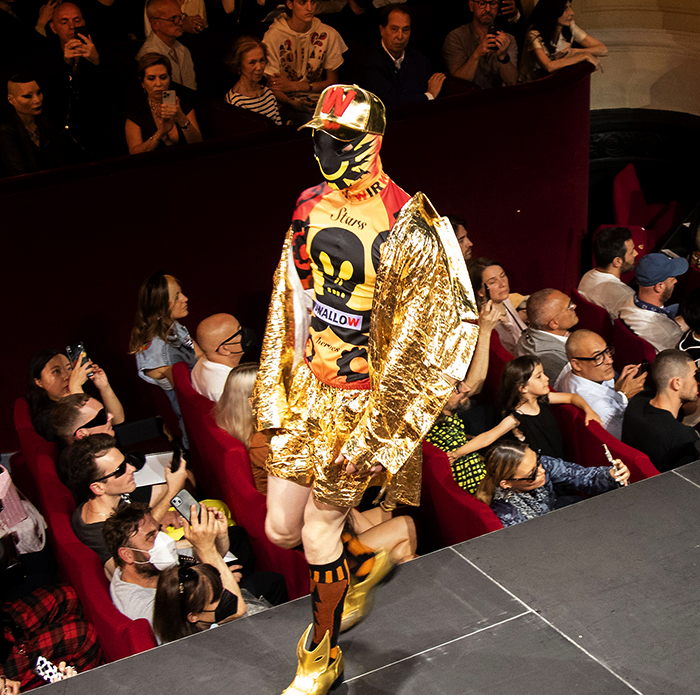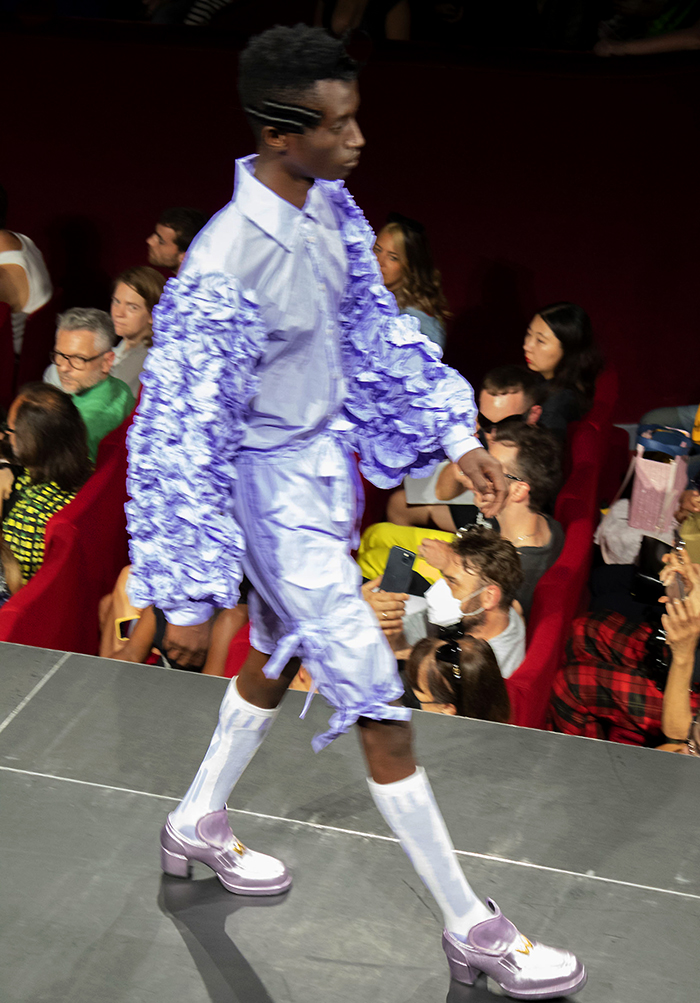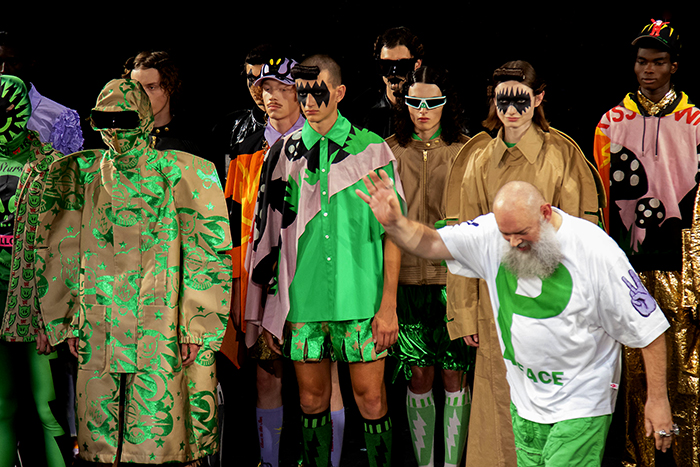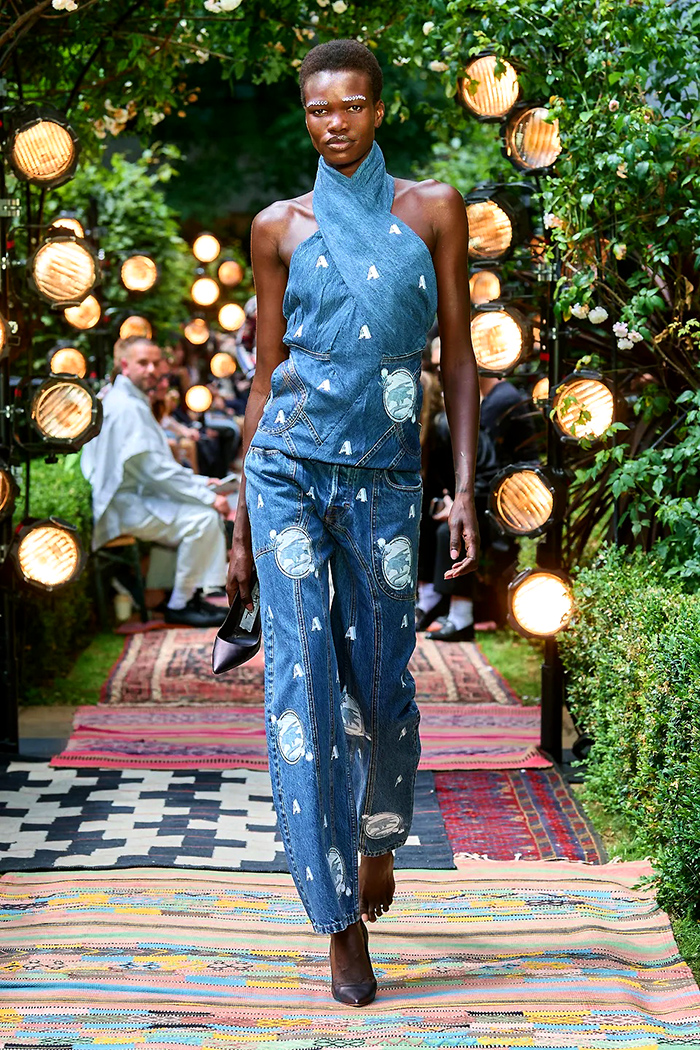"The deeper the blue becomes, the more strongly it calls man towards the infinite, awakening in him a desire for the pure and, finally, for the supernatural...The brighter it becomes, the more it loses its sound, until it turns into silent stillness and becomes white." ~ Wassily Kandinksy
 |
The origami-like set representing the Earth, designed by Yuima Nakazato for his Paris show. Photograph; Mathew Fisher |
"The glimpses of sky visible through the buildings outside my window in Tokyo brought to mind the rest of our shared planet," the designer said.
"Almost in a state of prayer, I worked towards the creation of this collection. To our eyes, the sky and the sea both appear blue, but this is nothing more than a visual phenomenon. Dipping a piece of cloth into the ocean will not turn it blue. This color is a mystery we can see it with our eyes, and yet it doesn’t really exist. Wearing blue garments, I thought, might almost make a person feel as if they were draped in messages from one of the avatars of old."
Thoughtful and self-contained, Yuima Nakazato is expanding his manifesto of experimentation: new materials and technology combined with superb artisanship. This Japanese dynamo is doing some of the most interesting and far-reaching work among not only the couturiers on the official Paris schedule but among contemporary designers today. He thinks beyond each fashion show to his cohesive vision that encompasses creating sustainable textiles and a couture that could be worn potentially by everyone.
Yuima Nakazato is doing some of the most interesting and futuristic work among contemporary fashion designers today
 |
The evocative runway show with the bride in her cascade of silken, white chiffon. Photograph: Elli Ioannou |
The labour intensive, hand-sewn garments are made of expensive fabrics and are, of course, costly to purchase. Yuima Nakazato is challenging some of these sacred couture premises while still maintaining the beauty and uniqueness that is central to the haute couture ethos.
Although the designer's ideas are cutting edge and full of new technology, he never loses sight of the poetry amid the science. He brings a romantic, appealing aesthetic to his collections that transcend even his more avant-garde creations that are full of dark drama, from alien elfin ears to long prosthetic arms.
He doesn't let his interest in the latest technological developments overwhelm his creativity. His vision has the potential to change the future of fashion and yet he manages to create pieces that are desirable to wear. His radical ideas inform his design philosophy while still making interesting, beautiful clothes.
Designing his latest collection before it's presentation at Paris Haute Couture Week this month, Yuima Nakazato says he felt overwhelmed by what was happening in the world and online and decided he needed to come back to the grounding work of doing things by hand. The Blue collection is the second physical runway show he has held in Paris since the pandemic put them on hold for two years.
The designer's ideas are cutting edge and full of new technology yet he never loses sight of the poetry amid the science
 |
Ethereal silk creations were contrasted with protean kimono-like robes. Photograph; Elli Ioannou |
"While digitization is a big trend in the world, we also focused on making our creations in this collection by hand," he explains. "We actively adopted the traditional techniques that have been inherited over generations to make the kimono. For example, indigo dyeing, lacquer, embroidery and split weaving. Also, this collection is made with a rectangular pattern as much as possible. This is also an ancient kimono philosophy that does not waste fabric."
One of Yuima Nakazato's central aims is to make fashion as sustainable as possible. As fabrics are produced in rectangular form, his designs inhibits the loss that occurs during the production of clothes. Inspired by the kimono, the new collection used that shape in different ways. Obviously a single rectangle does not suit the human body but joined together it can ~ and results in a garment that fits anyone.
"We are studying more about the philosophy of the kimono, which has a structure that changes and fits everyone's body," says the designer. "I am incorporating this concept into my design. Since the kimono is made of rectangles, it does not actually have the shape of a human body but it fits everyone at the same time.
"In other words, the approach to garment-making is completely different from that of the West, which tries to make it fit the three-dimensional human body. I believe this Oriental approach to the body goes beyond modern mass-customization concepts, that it can be tailored to each person."
"While digitization is a big trend, we focused on making our creations by hand. We adopted traditional techniques inherited over generations to make the kimono."
 |
Backstage in Paris, a model adjusts the ceramic neckpieces designed by Yuima Nakazato. Photograph: Elli Ioannou |
"If we treat garments as extensions of our bodies, then wouldn’t it make sense for them to change alongside us?" he questions. He has turned not only to the latest technology to explore this idea but has also looked to Japanese history.
"Traditional Japanese garments are never actually finished, they are constantly being repaired, darned, and patched. Sleeves get replaced, the obi gets adjusted, and hems get shortened. These alterations ensure that kimonos can fit people of all shapes and sizes. With transformation at it's core, the kimono inspired ideas of dynamic movement in this collection."
Nakazato and his team work with local craftsmen so that traditional handicrafts and methods are part of his designs and support Japanese kimono culture and preserve it for the future. Examples are Kiryu's embroidery and split weaving, Tokushima's indigo dyeing and Kyoto's use of lacquer.
With his signature combination of fusing technology with craftmanship, Nakazato is experimenting with a range of different techniques that will make producing fashion kinder to our planet: from testing the use of new plant-based materials to using up fabrics that have been thrown on the scrap heap.
Nakazato and his team work with local craftsmen so that traditional handicrafts and methods are part of his designs and support Japanese kimono culture
 |
The designer created an abstract yet enchanted atmosphere at his Paris show. Photograph: Elli Ioannou |
"That said, plant-derived fabrics are not always environmentally friendly. The important thing is, before looking at the material, whether the wearer will continue to use it for a long time.
"The designer should consider not only durable and long-lasting materials, but also a design that transcends trends. However, I think that the kimono culture of the Edo period in Japan had all these elements. I believe that it can be realized even in modern times."
Each collection now includes Yuima Nakazato's Type-1 garment production system which eschews the traditional needle-and thread. The garments are put together using specially-designed snap fastenings. So pieces can easily be changed and modified to suit the individual. This is central to his aim that unique clothes can be designed for many wearers. It also means a damaged part of a garment can be easily replaced and thus extends its lifetime. The designer believes that this system means anyone can be encouraged to make clothes either for themselves or as a business.
"I continue to use Type-1 as a standard," Nakazato says. "In design, I am pursuing something that dynamically changes, and with this system, not only can it be customized, but also the size can be changed, and even a belt like a kimono belt can be styled. By combining them, the areas of the changes that you can make will expand even more."
 |
Yuima Nakazato's fabrics were specially dyed to create textural, almost 3D patterns. Photograph Elli Ioannou |
The material's shape can be controlled through digital fabrication. While petroleum-derived textiles such as polyester keep their shape with heat processing, natural dyes don't take hold. However, using biosmocking, the synthetic protein can take natural dyes, and the shape can also be controlled.
"Biosmocking has made great strides this season," Yuima Nakazato says. "Until now, digital UV printing has been used to control the shrinkage of the fabric and form the shape, but this time we succeeded in combining it with the traditional technique of indigo dyeing (combined with lacquer) and tie-dyeing: 'shibori'. Since it is made from natural dyes, it is not only 100% biodegradable, but also has unprecedented suppleness.
"Fusing this approach with traditional kimono production techniques such as the use of indigo dye, lacquer, and tie-dyeing allows us to balance shape retention with flexibility and improve material biodegradability by shifting away from petroleum-based inks, resulting in a further demonstration of biosmocking’s value as a garment production technology. "
Another aspect to Nakazato's sustainability philosophy is using surplus textiles. For this collection, the designer and his team asked companies, from clothing brands to manufacturers, to let them use their leftover fabric. They collected redundant textiles that could not be sold and others that were remaindered and would eventually end up as landfill.
"I wanted to create something beautiful from these dregs, from surplus materials that would usually be regarded as little more than industrial waste."
 |
Couturier Yuima Nakazato backstage before his Paris haute couture show with his film camera. Photograph: Elli Ioannou |
"With a small shift in perspective, however, they can become something entirely new. I wanted to create something beautiful from these dregs, from something that would usually be regarded as little more than industrial waste. That perspective is something I wanted to challenge through this collection."
Important to producing ecologically-aware fashion is making sure garments are made of a single material. After visiting processing facilities and recycling centers where garments are disposed of, Nakazato realized the importance of taking into account how garments will be treated, once they become waste or are upcycled, during the process of designing them.
"Wherever possible, the pieces in this collection feature mono-materials. We have endeavored to avoid sewing different types of materials together. This approach should result in garments which are easier to recycle and which have a lower chance of ending up as landfill or in the incinerator."
Looking at fashion as a whole and its effect on the environment, the designer believes we also need to come back to an appreciation of the hand-made. "There was a time when most clothes were made at home. In the past, the person who wore the garments and the person who made them were close by, and many people had the skills to make clothes. In a sense, this was a world where people only wore bespoke garments."
"The ultimate garment I would like to create, is one that is a 'living thing,' constantly altering its appearance according to the wearer's body and the external environment."
 |
Celebrating backstage at the Palais de Tokyo. after the successful haute couture show. Photograph; Elli Ioannou |
"The ultimate garment I would like to create, is one that is a 'living thing,' constantly changing, metabolized and altering its appearance according to the wearer's body and the external environment. When it's role is finished, it returns to the soil. How can we achieve this? That is what I have in my mind for the future."
Scroll down to see highlights from Yuima Nakazato's AW 2022/23 Haute Couture collection
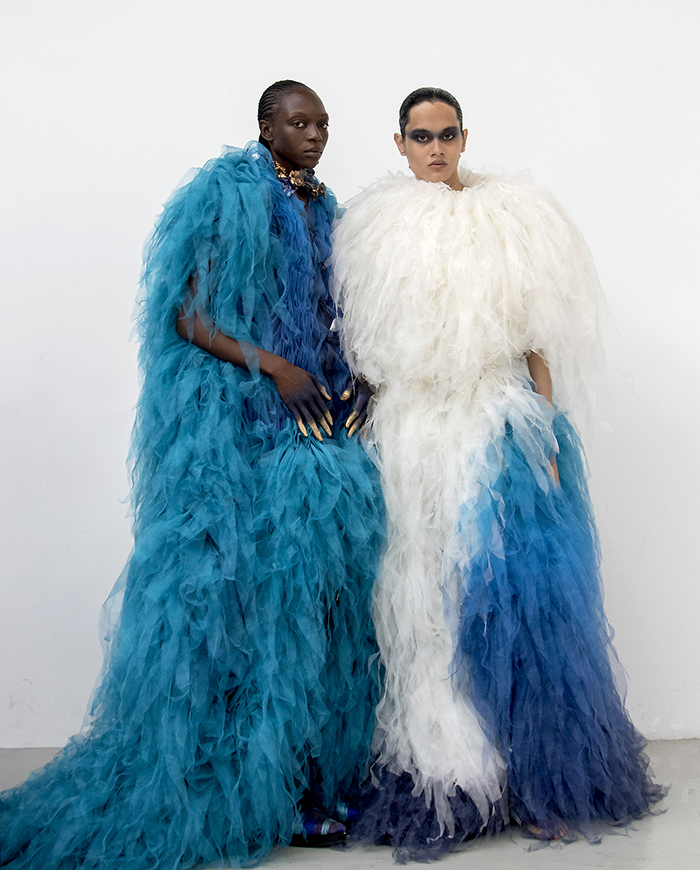 |
| Backstage in Paris at the Palais de Tokyo before the show, dressed in filmy, silk robes of blue. Photograph: Elli Ioannou |
 |
| The origami-like set designed by Yuima Nakazato in paper to represent our Blue Planet. Photograph: Elli Ioannou |
 |
| A model wearing the sculptural ceramic neckpiece specially designed by Nakazato for this collection. Photograph: Elli Ioannou |
 |
Even from discarded surplus fabric stock, Nakazato was able to transform the textiles into beautiful creations. Photograph: Elli Ioannou |
 |
| A long, fluid robe inspired by the rectangular forms of the kimono. Photograph: Mattew Fisher |
 |
| A wonderfully feathery, creamy silk bridal gown with an avant-garde aesthetic was the finale of the show. Photograph: Elli Ioannou |
 |
| A close-up of the potent ceramic sculpture necklace created by the Japanese designer. Photograph: Elli Ioannou |
 |
| A long, flowing gown with specially-dyed textural details was a feature of this collection. Photograph: Elli Ioannou |
 |
| During the show, the models walked tin futuristic cloaks amid the evocative set which was suggestive of rocky terrain. Photograph; Elli Ioannou |
 |
| Backstage at Yuima Nakazato's haute couture show, the models gather at the Palais de Tokyo in Paris. Photograph: Elli Ioannou |
 |
| A symphony of blues and whites, the models almost merged with the blue paper landscape created from Nakazato's drawings. Photograph; Elli Ioannou |
 |
| A cloud-like interpretation of a contemporary kimono in a diaphanou ensemble of variegated blues. Photograph; Elli Ioannou |
 |
| A voluminous blue and white creation with a sculptural belt that looks both comfortable and elegant. Photograph: Elli Ioannou |
 |
The designer mixes experiments with new materials like brewed protein along with using traditional Japanese artisans for embroidery and hand-dying. Photograph; Elli Ioannou |
 |
| Sustainability is also key to Nakazato's work and he and his team look at the processes from beginning to end of how a garment is made, including the textiles. Photograph; Elli Ioannou |
 |
Considering fashion as a whole and its effect on the environment, the designer believes we also need to come back to an appreciation of the hand-made.Photograph; Elli Ioannou |
 |
Nakazato brings a romantic, appealing aesthetic to his collections that transcend even his more avant-garde creations that are full of dark drama. Photograph; Elli Ioannou |
 |
"Wherever possible, the pieces in this collection feature mono-materials," says the designers. "We have endeavored to avoid sewing different types of materials together." Photograph: Elli Ioannou |
 |
"We are studying more about the philosophy of the kimono, which has a structure that changes and fits everyone's body," says Nakazato. "I am incorporating this concept into my design." Photograph: Elli Iaonnou |
 |
Each collection now includes Yuima Nakazato's Type-1 garment production system which eschews the traditional needle-and thread. The garments are put together using specially-designed snap fastenings. Photograph: Elli Ioannou |
 |
"We created this collection by using 'dead stock': materials without a purpose, left waiting in storage," Yuima Nakazato explains."With a small shift in perspective, however, they can become something entirely new." Photograph: Elli Ioannou |
 |
Blue is the title of couturier Yuima Nakazato's new collection. Blue for how he felt during the pandemic, blue for the sky outside of his window in Tokyo and blue for our planet. Photograph: Elli Ioannou |
 |
Nakazato and his team work with local craftsmen so that traditional handicrafts and methods are part of his designs and support Japanese kimono culture and preserve it for the future. Photograph: Elli Ioannou |
 |
Thoughtful and self-contained, Yuima Nakazato is expanding his manifesto of experimentation: new materials and technology combined with superb artisanship. Photograph; Elli Ioannou |
 |
| A happy Yuima Nakazato among his models after presenting his collection in Paris, only his second physical runway show since the pandemic put them on hiatus for two years. Photograph: Elli Ioannou |



















